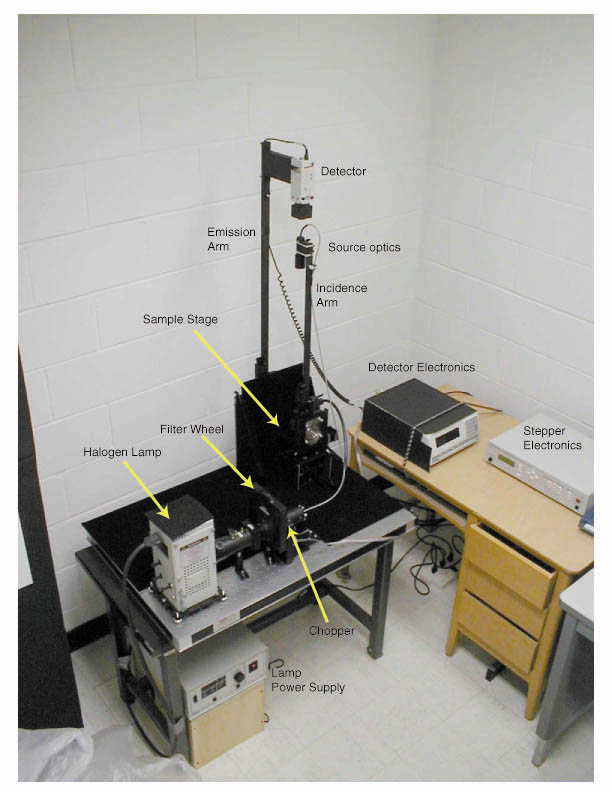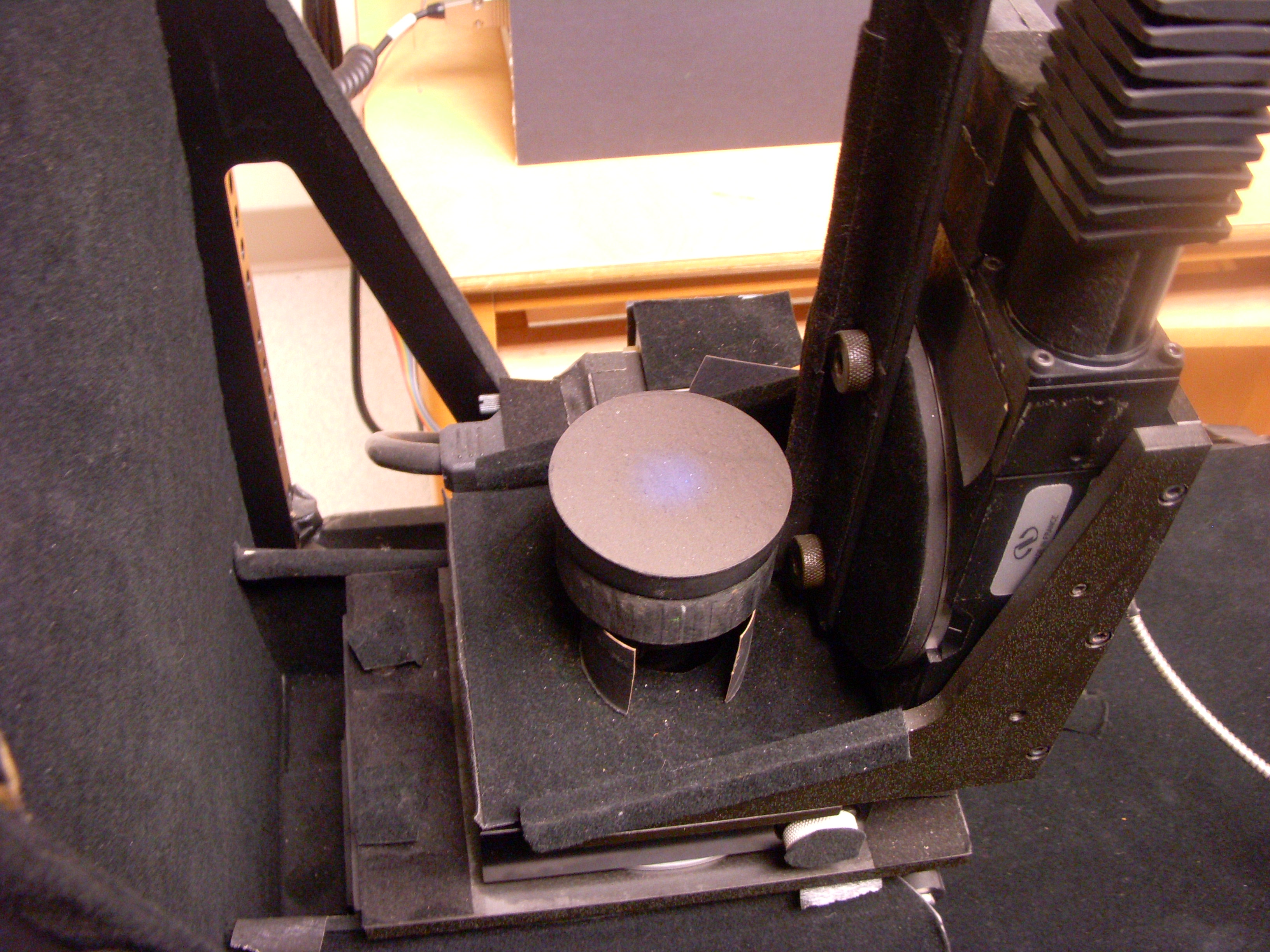

B. U. Goniometer (B.U.G.) Laboratory
Funded by NASA Planetary Geology and Geophysics Program
What is Planetary Photometry?
Planetary photometry is the study of the way light reflects from the surfaces of planets and how we can use it to learn more about the planet. Virtually all of our observations of planets, asteroids, and comets comes from the sunlight reflected off of these objects. It might be seen through a large ground-based telescope, or from an orbiting camera, or a camera mounted on a lander or rover. The BU Goniometer, or BUG lab, was designed to measure how light is reflected from materials in a controlled setting; once we understand the process, we can apply that knowledge to the data we gather from our telescopes and cameras.
BUG Lab and Photometric Goniometers
A photometric goniometer measures the reflected light properties of surfaces from a variety of illumination and viewing positions. The majority of goniometers being used for planetary applications are limited, either by design or use, to measurements in the principal (or scattering) plane.
This instrument was designed to measure the scattering properties over the entire upper hemisphere. Additionally, it is an automated system that utilizes stepper motors and motion control and measurement software. The light source is a 100W quartz-tungsten-halogen research grade lamp. The output light is filtered using 50nm FWHM interference filters within the visible and near-infrared (400-1000 nm range), then chopped and focused into a glass fiber-optic bundle. The fiber optic cable terminates at the top of one of the two arms (incidence arm) with a collimating lens assembly, where it is then directed onto the sample. The source arm is capable of incidence angles of 0-60 degrees (depending on sample size), and also swivels in azimuth from 0-170 deg. The reflected light is detected by a silicon-detection system which is "locked in" to the chopper, and provides very stable, low noise measurements, even in low-level ambient light.
The detector is mounted on the longer arm (emission arm) and is capable of emission angles of -80 to +80 deg. The degree of movement described here allows a complete half-hemisphere of scattered light to be measured (including the principal plane). For isotropic samples, the other half-hemisphere is theoretically the mirror image (across the principal plane) of that measured, and this is checked at selected places. The width of the collimating lens and it's distance from the sample limits the phase angle to a minimum of 3.0 deg (the detector is occulted by the optics at smaller phase angles). The maximum useful phase angle is 140 deg for most applications, but with special sample holders we have gone up to 160 deg or so for a few samples.


(Left) Goniometer in "parked" position (i=0, e=0, az=0). The detector is on the emission arm. The light source is directed along the incidence arm and terminates in a small collimating lens at the top.
(Right) A sample on the sample stage. It is being illuminated by a blue light. Credit: E. Foote.
Spectrograph. A single-grating spectrograph (Oriel Corp. FICS/Linespec system) is also available to document the characteristics of each sample. Spectral coverage is 400-1000nm with spectral resolutions of ~6nm.
CCD Camera System. In the past, a Panasonic CCD color video camera was used to capture images of the surface with resolutions as high as 60um (15um pixels) at a 1cm FOV. That system has passed on and we now use binocular microscopes equipped with digital cameras to document the samples.
Recent Work
Models of Bidirectional Reflectance
The BUG lab was originally designed to test bidirectional reflectance models - could they be used to extract physical information about
a regolith? With Paul Helfenstein (Cornell University) and others, I tackled this problem by measuring the BRDF of a wide variety of powdered samples, most of which were uniform in characteristics. Some had strong color contrasts so we could see how the reflectance might affect the BRDF. Papers that report our findings are found here.
Shepard and Helfenstein, 2011. A laboratory study of the bidirectional reflectance from particulate samples. Icarus 215, pp. 526-533. doi:10.1016/j.icarus.2011.07.033
Helfenstein and Shepard, 2011. Testing the Hapke photometric model: Improved inversion and porosity correction. Icarus 215, pp. 83-100. doi:10.1016/j.icarus.2011.07.002
Hapke, Shepard, et al. 2009. A quantitative test of the ability of models based on the equation of radiative transfer to predict the bidirectional reflectance of a well-characterized medium. Icarus 199, pp. 210-218. doi:10.1016/j.icarus.2008.09.006
Shepard and Helfenstein 2007. A test of the Hapke photometric model. Journal of Geophysical Research 112, doi:10.1029/2005JE002625
Foote, E.J. et al, 2020. The bidirectional and directional hemispheric reflectance of Apollo 11 and 16 soils: Laboratory and Diviner measurements. Icarus 336, 113456. doi:10.1016/j.icarus.2019.113456
Shepard, Foote, & Paige 2016. Apollo Lunar Sample BUG Observations. BUGLAB-L-BUG-4-APOLLO-SAMPLES-V1.0. NASA PDS
Johnson, Shepard et al 2013. Spectrogoniometry and modeling of martian and lunar analog samples and Apollo soils. Icarus 223, pp. 383-406. doi:10.1016/j.icarus.2012.12.004
Shepard 2006. Mars Analog Soil BUG Observations. BUGLAB-E-BUG-4-V1.0. NASA PDS
Photographs
JSC Mars-1 Analog Soil